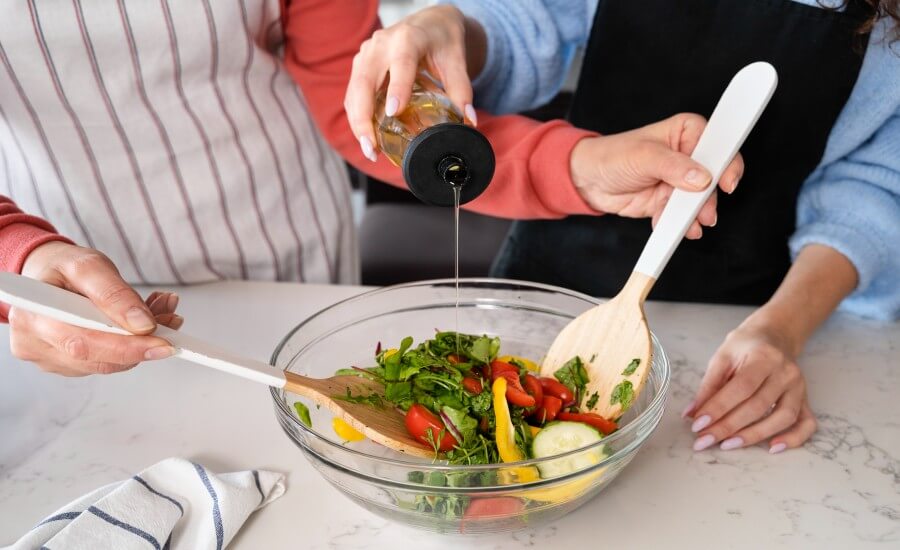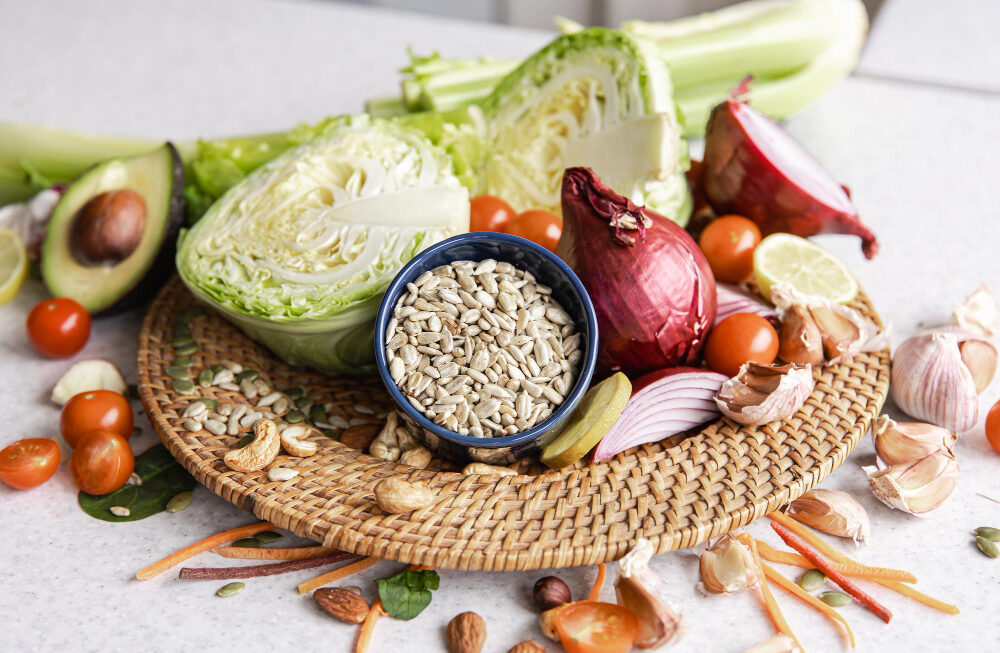A quick stir-fry is a weeknight hero – fast, fresh, and packed with vegetables. But what truly elevates a simple stir-fry from decent to dazzling is the sauce! It’s the soul of the dish, bringing all the ingredients together in a symphony of flavour. While bottled sauces offer convenience, crafting flavorful vegan stir-fry sauces at home is surprisingly simple and unlocks a universe of taste possibilities far beyond basic soy sauce. This guide explores the art of creating sensational vegan stir-fry sauces, examining nutritional aspects, ethical considerations, the science of flavour, environmental impacts, and providing practical recipes and formulas adaptable for any kitchen, including incorporating the vibrant tastes and ingredients of India, right here in Jaipur.
LENS 1: Nutritional Analysis (Flavor Without the Flaws)
Homemade vegan stir-fry sauces empower you to control the nutritional profile, often resulting in healthier options compared to commercial sauces or typical takeout.
- Sodium Savvy: Bottled stir-fry sauces, including soy sauce, tamari, and pre-mixed options, are often notoriously high in sodium. Making your own allows you to use lower-sodium soy sauce/tamari or control the amount added, balancing it with other flavourings.
- Sugar Smarts: Many commercial sauces (Teriyaki, Sweet & Sour, some Chili sauces) contain significant amounts of added sugar or high-fructose corn syrup. At home, you can use less sweetener overall, or opt for natural alternatives like date paste, maple syrup, or local Indian options like jaggery (gur), which add flavour nuances alongside sweetness.
- Fat Facts: Homemade sauces allow control over the amount and type of fat. You can use minimal amounts of healthy oils (sesame, groundnut), incorporate healthy fats via tahini or peanut butter bases, or even create flavourful oil-free sauces using vegetable broth and potent aromatics. This contrasts with some restaurant stir-fries that can be heavy on oil.
- Nutrient-Dense Flavor Bases: Homemade sauces rely on fresh, nutrient-rich ingredients for flavour:
- Aromatics: Ginger (adrak) and garlic (lehsun) are packed with beneficial compounds.
- Spices & Herbs: Turmeric (haldi), chili, coriander (dhania), cumin (jeera), fresh herbs like coriander leaves or mint (pudina) add flavour and antioxidants/phytonutrients.
- Acidity: Lemon/lime juice or vinegar provide Vitamin C and bright taste.
- Avoiding Additives: Making sauces from scratch eliminates potentially unwanted preservatives, MSG (though plant sources of umami offer alternatives), artificial colours, or thickeners found in some commercial products. How can you reduce the sodium or sugar content in your go-to stir-fry sauce recipe by using fresh aromatics, spices, or acidity for flavour instead?
Nutritional Deep Dive: Sodium & Sugar Savvy in Stir-Fry Sauces
- Sodium: Soy sauce/tamari are inherently salty. Use them as the primary salt source. Choose lower-sodium versions if available. Balance saltiness with acidity (vinegar/lime) and a touch of sweetness. Taste before adding extra salt. Vegetable broth can replace some water for flavour without high sodium.
- Sugar: Many Asian-inspired sauces need sweetness for balance. Use minimally. Date paste offers fiber and minerals alongside sweetness. Jaggery (gur) provides a complex, molasses-like sweetness common in Indian cooking. Maple syrup or agave are other options. Even unsweetened fruit juice (pineapple) can work in sweet & sour sauces.
Voice of Experience (Registered Dietitian & Cook): “Homemade stir-fry sauces are a game-changer for healthy eating. You ditch the excessive sodium, sugar, and additives found in many bottled versions. Instead, build flavour with fresh ginger, garlic, herbs, spices, a touch of healthy fat, and balanced acidity. It’s easy to make sauces both incredibly flavourful and nourishing.” – Priya Sharma, RDN
Read more: Quick Vegan Stir‑Fry Recipes for Easy Weeknight Meals
LENS 2: Ethical Framework (Conscious Condiments)
Mixing your own vegan stir-fry sauces aligns with several ethical considerations.
- Ingredient Transparency & Sourcing: Making sauce from scratch provides complete transparency. It allows you to choose ethically sourced components: Fair Trade certified soy sauce/tamari, sugar/jaggery, spices (cardamom, pepper, cloves), coffee, or oils. You can prioritize supporting brands with ethical labour practices for nuts/seeds.
- Reducing Packaging Waste: This is a significant benefit. Homemade sauces eliminate the need for multiple plastic or glass bottles required for various commercial sauces, drastically reducing household packaging waste. Buying base ingredients like soy sauce or vinegar in larger containers is often possible.
- Celebrating Local Flavours: Incorporating locally available souring agents (like tamarind/imli pulp instead of imported rice vinegar), sweeteners (jaggery/gur), fresh herbs (coriander/dhania, mint/pudina), and regional chilies connects your cooking ethically to your locale (Jaipur/Rajasthan).
- Respectful Fusion: When creating fusion sauces (e.g., Indo-Chinese or Thai-inspired with Indian twists), doing so mindfully involves understanding and respecting the origins of the flavour profiles being combined.
- Sharing Homemade Goodness: Gifting a jar of unique homemade stir-fry sauce or serving it as part of a meal is a personal, thoughtful, and compassionate gesture. Does making your own sauce from ethically sourced components enhance your feeling of cooking with integrity?
Hidden Benefits: Culinary Confidence & Creativity
Mastering a few basic sauce formulas builds immense culinary confidence and opens the door to endless creative experimentation based on pantry staples and seasonal availability, moving beyond reliance on pre-made products.
Voice of Experience (Low-Waste Cooking Blogger): “Bottled sauces are a huge source of kitchen packaging waste! Mixing my own stir-fry sauces takes minutes using staples like soy sauce, vinegar, ginger, garlic, and maybe some peanut butter or tahini. It’s cheaper, tastes fresher, avoids additives, and completely cuts out the plastic bottle waste. It’s an easy ethical win.” – @ZeroWasteJaipurKitchen (hypothetical handle)
Critical Reassessment: Accessibility & Authenticity Claims
While promoting homemade, acknowledge that certain specific condiments needed for authentic regional Asian sauces (e.g., specific fermented bean pastes, gochujang) might be less accessible or affordable everywhere in India compared to basic soy sauce or local spices. Balance creativity with practicality, and be cautious about claiming absolute authenticity for simplified/fusion versions.
LENS 3: Ingredient Science & Environment (The Alchemy of Sauce & Sustainability)
Understanding the science behind flavour and texture helps craft superior sauces sustainably.
- The Science of Sauce:
- Flavor Balancing: Great sauces balance the five tastes: Salty (soy sauce, salt), Sweet (sugar, jaggery, maple, fruit), Sour (vinegar, lime/lemon, tamarind/imli, kokum), Bitter (sometimes from greens, certain spices), and Umami (savory depth from soy sauce, tomatoes, mushrooms, nutritional yeast, miso).
- Thickening (Starch Gelatinization): Cornstarch (or tapioca/arrowroot) mixed with cold water (slurry) thickens rapidly when added to hot liquid. The starch granules absorb water, swell, and burst, creating a viscous network.
- Emulsification: In creamy sauces like peanut or tahini sauce, blending helps create a stable emulsion where oil droplets from the nut/seed butter are dispersed in the water-based ingredients (broth, soy sauce, lime juice).
- Aromatic Release: Sautéing ginger, garlic, and spices in oil before adding liquids helps release fat-soluble flavour compounds, creating a more aromatic and complex sauce base (essential for tadka).
- Environmental Impact:
- Plant-Based Advantage: Vegan sauce ingredients (soy, vegetables, spices, plant oils) generally have a much lower environmental footprint than non-vegan counterparts like fish sauce (overfishing concerns), oyster sauce, or cream/butter bases.
- Ingredient Footprints: Soy production has complexities (land use change in some regions), but is still generally lower impact than animal agriculture. Sugar production involves water and land use. Choosing locally sourced spices, aromatics, acids (lemon, tamarind), and sweeteners (jaggery) reduces food miles.
- Packaging & Transport: Making sauces at home avoids the significant packaging (plastic/glass bottles) and transport emissions associated with shipping heavy, pre-made liquid sauces globally or nationally.
- Water Use: Primarily related to growing ingredients. Using concentrates (like tomato paste or tamarind pulp) reconstituted at home can be more water-efficient in transport than shipping high-water sauces. How does using a local souring agent like tamarind (imli) instead of imported rice vinegar impact the sustainability of your sauce?
Market Transformation Map Suggestion: Data showing increased retail sales of individual sauce components like tamari, various vinegars, tahini, sesame oil, and diverse chili pastes, indicating a trend towards more consumers mixing their own sauces.
Voice of Experience (Food Scientist): “A great stir-fry sauce is culinary chemistry in action. You’re balancing hydrophilic and hydrophobic molecules with emulsifiers in creamy sauces, managing starch gelatinization for thickness, and optimizing flavour release from aromatics through heat. Understanding these principles allows for endless creative and delicious vegan combinations.” – Dr. Meera Iyer, Flavor Chemistry Lab
LENS 4: Everyday Practitioner’s Experience (Recipes, Formulas & Tips)
Let’s get mixing! Here are practical formulas and recipes for flavorful vegan stir-fry sauces you can make quickly.
The Stir-Fry Sauce Formula (Mix & Match):
- Base (Salty/Umami – 2-4 parts): Soy Sauce (Shoyu/Tamari-GF), Vegetable Broth, Coconut Aminos (less salty).
- Acid (Sour – 1 part): Rice Vinegar, Apple Cider Vinegar, Lime/Lemon Juice, Tamarind (Imli) Paste/Water.
- Sweetener (Sweet – ½ – 1 part, adjust to taste): Maple Syrup, Agave Nectar, Jaggery (Gur) syrup/grated, Date Paste, Brown Sugar, Coconut Sugar.
- Aromatics (Flavor Depth): Minced/Grated Ginger (Adrak), Minced/Grated Garlic (Lehsun), Chopped Green Chilies, Toasted Sesame Oil (use as finishing oil mostly), Onion/Garlic Powder.
- Umami Boosters (Optional): Mushroom Powder, Miso Paste (dissolve first), Nutritional Yeast.
- Thickener (As needed): 1-2 tsp Cornstarch or Tapioca Starch mixed with 1-2 tbsp COLD water (slurry). Add at the end to simmering sauce.
- Spice/Heat (Optional): Red Pepper Flakes, Chili Garlic Sauce, Sriracha, Black Pepper, Indian Spice Powders (cumin, coriander – bloom in oil first ideally).
Quick Recipe Ideas (Combine ingredients in a jar/bowl, whisk well):
- Basic Garlic-Ginger: 3 tbsp Soy Sauce, 1 tbsp Water/Broth, 1 tsp Maple/Jaggery, 1 tsp Grated Ginger, 1 Clove Minced Garlic, 1 tsp Cornstarch slurry (optional, add at end). Finish with ½ tsp sesame oil if desired.
- Spicy Peanut Sauce: 3 tbsp Peanut Butter, 2-3 tbsp Water (to thin), 1 tbsp Soy Sauce, 1 tbsp Lime Juice, 1 tsp Maple/Jaggery, ½ tsp Grated Ginger, pinch Chili Flakes/Dash Hot Sauce. (Great for noodles/tofu).
- Creamy Tahini-Lemon: 3 tbsp Tahini, 2-3 tbsp Water (to thin), 2 tbsp Lemon Juice, 1 Clove Minced Garlic, Salt & Pepper to taste. (Excellent drizzled over roasted veg bowls/stir-fries).
- Simple Sweet & Sour: ¼ cup Pineapple Juice (or water), 2 tbsp Rice Vinegar, 1-2 tbsp Sugar/Jaggery, 1 tbsp Soy Sauce, 1 tbsp Ketchup (optional), 1 tbsp Cornstarch slurry.
- Ginger-Tamarind (Indian Tang): 2 tbsp Tamarind (Imli) Pulp/Water, 2 tbsp Water/Broth, 1 tbsp Jaggery/Sugar, 1 tsp Soy Sauce, 1 tsp Grated Ginger, pinch Chili Powder, ½ tsp Cornstarch slurry.
Tips for Success:
- Mix Ahead: Combine sauce ingredients (except cornstarch slurry) in a jar and shake well. Store in the fridge for several days for even quicker weeknight meals.
- Taste & Balance: Always taste your sauce before adding it to the stir-fry. Adjust salty/sweet/sour/spicy balance as needed. Remember flavours concentrate slightly when heated.
- Thicken at the End: Add cornstarch (or tapioca/arrowroot) slurry to the hot stir-fry after adding the main sauce liquid. Stir constantly until it thickens (takes less than a minute). Start with less slurry; you can always add more.
- Fresh vs. Paste: Freshly grated ginger and garlic offer the best flavour, but good quality ginger-garlic paste (a staple in Indian kitchens) works well for speed.
- Bloom Spices: For deeper Indian flavours, briefly sauté whole spices (cumin/mustard seeds) or ground spices (turmeric, coriander) in the initial stir-fry oil before adding vegetables.
What flavour profile (savory, spicy, sweet, tangy, creamy) do you gravitate towards most for stir-fry sauces?
Daily Impact: The Sauce Jar Solution
Keep a jar of your basic go-to stir-fry sauce mixed in the fridge. This simple step transforms weeknight stir-frying from a multi-step process to simply chopping veggies and cooking.
Voice of Experience (Busy Home Cook): “I stopped buying bottled stir-fry sauces ages ago! My basic mix is just soy sauce, water, a touch of jaggery, ginger-garlic paste, and cornstarch slurry. Takes two minutes to whisk together. I change it up by adding lime juice, peanut butter, or chili sauce sometimes. So easy, cheap, and way healthier!” – Rekha Patel, Jaipur
Alternative Approaches: Using Pastes & Chutneys
- Curry Paste Base: Use a tablespoon of store-bought or homemade vegan Thai curry paste or even some Indian curry pastes as a flavour base, thinned with broth or coconut milk.
- Chutney/Pickle Element: A small amount of tangy Indian pickle (achar) or sweet mango chutney added to a basic soy sauce base can create unique fusion flavours.
PERSPECTIVE INTERSECTION MATRIX
- Nutrition & Homemade (Lens 1 & 4): Making sauces at home (Lens 4) directly addresses nutritional concerns about sodium, sugar, and additives in commercial products (Lens 1).
- Ethics & Sourcing (Lens 2 & 4): Choosing Fair Trade or local ingredients (Lens 2) is put into practice when selecting components for homemade sauces (Lens 4). Reducing packaging waste (Lens 2) is a direct outcome (Lens 4).
- Environment & Ingredients (Lens 3 & 4): Using lower-impact ingredients like local tamarind or reducing packaging (Lens 3) occurs through practical homemade sauce preparation (Lens 4).
- Science & Flavour Balance (Lens 3 & 4): Understanding the science of balancing tastes and thickening (Lens 3) empowers home cooks to create consistently delicious and well-textured sauces (Lens 4).
- Practicality & All Factors (Lens 4 & 1/2/3): The ease and customizability of homemade sauces (Lens 4) make it simpler to achieve nutritional goals (Lens 1), align with ethical sourcing/waste reduction (Lens 2), and utilize sustainable ingredients (Lens 3).
MISCONCEPTION ANALYSIS
| Misconception | Reality |
| Making flavourful vegan stir-fry sauces from scratch is complicated and hard. | Most sauces are simple mixtures! Whisking together soy sauce, water, sweetener, aromatics (ginger/garlic), and a cornstarch slurry takes only a few minutes and basic pantry staples. |
| Vegan stir-fry sauces are basically just variations of soy sauce. | While soy sauce is a common base, vegan stir-fry sauces can be incredibly diverse: creamy peanut, tangy tahini-lemon, sweet & sour, spicy chili-garlic, rich mushroom, tamarind-based, using coconut milk, fruit juices, various vinegars, herbs, and spices. |
| You need MSG, fish sauce, or oyster sauce for authentic umami/depth. | Vegan sources provide ample umami! Soy sauce/tamari, mushrooms (fresh or powdered), nutritional yeast, tomato paste, miso, and even seaweed can create deep, savoury flavours. Proper cooking of aromatics and spices also builds complexity. |
| Homemade sauces won’t thicken properly without special ingredients. | Cornstarch (or tapioca/arrowroot) mixed with cold water (slurry) is a simple, highly effective, and readily available thickener for stir-fry sauces. Blended nuts/seeds/beans also thicken sauces naturally. |
| It’s not worth the effort; bottled sauces are just as good. | Homemade sauces offer superior freshness, allow complete control over ingredients (less salt/sugar, no additives), reduce packaging waste, are often cheaper per serving, and allow for infinite customization to your exact taste preferences. |
KEY TURNING POINTS
- Global Awareness of Asian Cuisines: Increased exposure to diverse stir-fry sauces beyond basic soy sauce (e.g., Thai peanut, Vietnamese nuoc cham adaptations, Korean flavours).
- Health Focus on Sodium/Sugar/Additives: Consumers becoming more aware of ingredients in processed foods, driving interest in healthier homemade alternatives.
- Veganism Seeking Alternatives: Need for plant-based replacements for traditional non-vegan sauce ingredients like fish sauce or oyster sauce spurred innovation with umami-rich plant sources.
- Food Blogs & Online Recipes: Made diverse sauce recipes easily accessible, demystifying the process and encouraging home cooks to experiment.
- Availability of Global Ingredients: Easier access to ingredients like tahini, different types of soy sauce/tamari, rice vinegar, chili pastes in mainstream stores.
SYNTHESIS & RECOMMENDATIONS
Unlock a world of taste and elevate your weeknight meals by mastering flavorful vegan stir-fry sauces at home. Moving beyond the basics is simple, rewarding, and puts you in complete control of nutrition, ethics, and taste. By understanding the core components – balancing salty, sweet, sour, spicy, and umami – and utilizing readily available plant-based ingredients like soy sauce, vinegars, natural sweeteners (like local jaggery!), aromatics, spices, and simple thickeners, you can create endless variations. Homemade sauces are fresher, healthier (less salt/sugar/additives), more sustainable (less packaging/transport), and often cheaper than bottled options. Embrace the ease and creativity of DIY stir-fry sauces!
Recommendations for Sensational Sauces:
- Master a Basic Formula: Learn the Base Liquid + Acid + Sweetener + Aromatics + Thickener formula as a starting point for customization.
- Prep Ahead: Mix sauce components (minus thickener) in a jar and store in the fridge for super-fast meal prep.
- Taste and Balance: Always taste and adjust seasonings before adding the sauce to your stir-fry. Aim for a harmonious balance of flavours.
- Use Fresh Aromatics: Fresh ginger and garlic generally provide superior flavour to powders, though pastes are a good shortcut.
- Thicken Correctly: Add cornstarch (or alternative) slurry mixed with cold water to the hot stir-fry at the very end, stirring until thickened.
- Explore Global & Local Flavours: Don’t stick to just soy sauce! Experiment with peanut butter, tahini, tamarind (imli), coconut milk, different chilies, vinegars, and Indian spice blends.
- Consider the Dish: Tailor the sauce to the main ingredients – lighter sauces for delicate vegetables, bolder sauces for tofu or heartier veg.
- Finish with Flair: A final drizzle of toasted sesame oil or a sprinkle of fresh herbs (coriander!) can elevate the finished dish.
FURTHER AREAS OF EXPLORATION
- The Science of Flavor Balancing: Achieving Salty-Sweet-Sour-Spicy-Umami Harmony
- A Guide to Different Asian Vinegars and Their Uses
- Homemade Vegan Teriyaki Sauce Recipe
- Peanut Sauces from Around the World (Veganized)
- Using Tamarind (Imli) in Savory Sauces and Dressings
- Oil-Free Stir-Fry Sauce Techniques & Recipes
- Making Indo-Chinese Sauces (Chili, Manchurian) Vegan at Home












